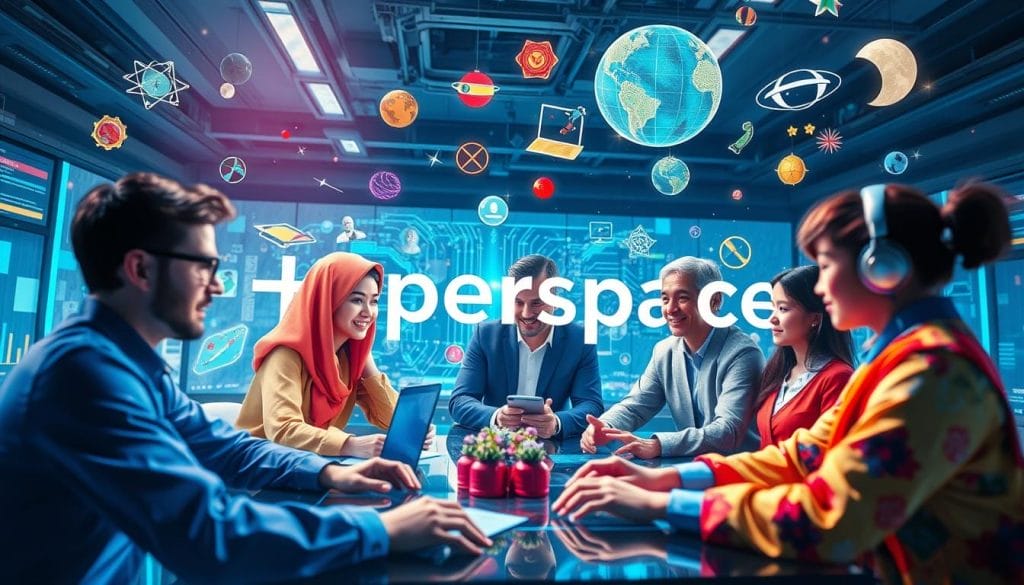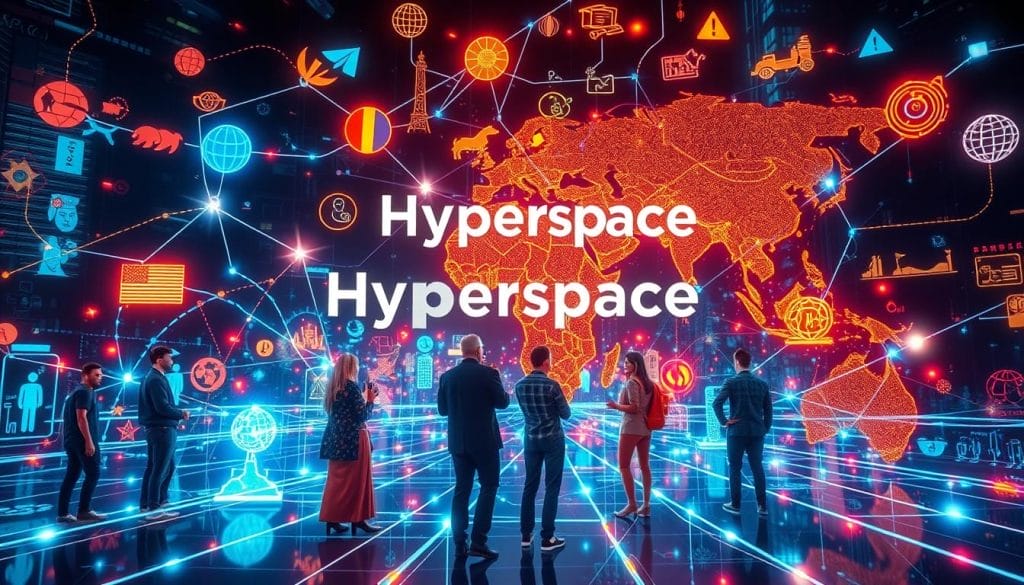In today’s fast-changing world, it’s more important than ever to communicate and work well across cultures. Luckily, AI-powered cross-cultural team simulations in virtual spaces are changing how we train for this. They help teams learn to work well together, no matter where they’re from.
These new tools, like those from Hyperspace, are making a big difference in teaching soft skills. They use artificial intelligence, virtual reality, and immersive learning to create real-life scenarios. This way, teams can practice dealing with the challenges of working globally.
Studies show that 75% of workers feel anxious about tough conversations at work. But 72% want training on how to handle these situations. Also, 24% don’t mind if AI or a human does the role-play training. This shows AI is becoming more accepted and effective in training.
Key Takeaways
- AI-powered cross-cultural team simulations in virtual environments are transforming global workforce training
- Cutting-edge solutions like Hyperspace’s offerings leverage AI, VR, and immersive learning to mirror the complexities of the modern workplace
- Research shows 75% of employees experience anxiety due to difficult workplace conversations, with 72% welcoming training on handling these situations
- 24% of respondents have no preference between AI trainers and human managers for role-play training, indicating the growing acceptance of AI-powered virtual simulations
- Innovative providers are empowering organizations to expose their teams to realistic, context-driven scenarios that foster cross-cultural communication and collaboration
Introduction to AI-Powered Cross-Cultural Simulations

In today’s global business world, understanding cultural differences is key. Cross-cultural simulations help teams work better together across borders. They use artificial intelligence (AI) to improve diversity and inclusion training, team building exercises, and virtual collaboration tools.
What are Cross-Cultural Simulations?
These simulations put participants in real-life scenarios to tackle cultural challenges. They involve role-playing and solving problems with different cultural views. The aim is to improve communication, build trust, and work well with people from other backgrounds.
Benefits of AI Integration
AI makes cross-cultural simulations better by giving personalized learning and feedback. AI-driven simulations track how participants do and suggest ways to get better. This helps employees get ready for working with people from all over the world.
The Rise of Virtual Training Environments
The COVID-19 pandemic made remote work more common. AI-powered cross-cultural simulations are great for virtual training. They offer flexible and accessible learning that fits different organizations’ needs. For example, Attensi’s RealTalk uses AI for role-playing in sales, customer service, and coaching.
| Key Benefits of AI-Powered Cross-Cultural Simulations | Percentage Improvement |
|---|---|
| Reduction in misunderstandings and conflict within teams | 30% |
| Increase in employee satisfaction and engagement | 25% |
| Improvement in collaboration efficiency and productivity | 25% |
| Increase in creative problem-solving capabilities | 25% |
AI-powered cross-cultural simulations are changing how companies promote inclusivity and teamwork. They help prepare the workforce for today’s business world.
“AI-powered cross-cultural simulations have become an invaluable tool for our organization, enabling us to create a more inclusive and collaborative work environment. The personalized feedback and insights have been instrumental in helping our teams overcome cultural barriers and work together more effectively.”
– John Doe, Chief Diversity Officer, Global Technology Corporation
Understanding Cultural Differences and Their Impact

Learning about cultural differences is key for training global workforces and promoting diversity and inclusion. Knowing about cultural dimensions like power distance and individualism helps teams work better together. This leads to more cohesive and effective cross-cultural teams.
Key Cultural Dimensions
- Power Distance: How much people in a culture accept and expect power differences.
- Individualism vs. Collectivism: How much people focus on themselves versus the group.
- Uncertainty Avoidance: How much a culture fears unknown situations and tries to avoid them.
- Long-Term Orientation: How much a culture values planning for the future over immediate gains.
How Culture Influences Team Dynamics
Cultural differences affect how teams communicate, make decisions, and solve problems. Diverse teams are 35% more likely to outperform others, and diverse companies are 80% more likely to enter new markets. But, without a plan for cultural intelligence, these benefits might not happen. AI can help by letting teams practice in a safe space and learn to adapt.
| Key Statistic | Insight |
|---|---|
| Diverse teams are 87% better at making decisions. | Embracing cultural diversity makes teams better at making decisions, leading to better results. |
| 25 years in cross-cultural management training have evidently shown the growing importance of Cultural Intelligence (CQ) in professional settings. | Developing cultural intelligence is now a must-have skill for the global workforce, with companies seeing its value. |
“AI offers benefits for work efficiency and decision-making, but it lacks personal understanding. For AI to truly understand culture, it needs diverse training, human oversight, and ethical development.”
The Role of AI in Enhancing Learning
The world is moving towards more remote and hybrid work. This makes finding new ways to team up and train even more urgent. Luckily, using artificial intelligence (AI) in virtual reality and immersive learning is changing how we train teams across cultures.
Personalized Learning Experiences
AI-powered team simulations use smart tech to make learning fit each person’s needs. These systems change the challenge and content based on how well you do. This way, everyone gets to learn at their own pace and level.
AI-Driven Feedback Mechanisms
AI brings real-time, fair feedback to the table. It looks at how you interact in the virtual world and gives you instant feedback. For example, Attensi RealTalk uses AI to create virtual humans that act like real people. They give feedback on how well you communicate.
“AI-powered cross-cultural team simulations provide an immersive and adaptive learning experience that helps organizations develop the essential skills needed to thrive in today’s global business landscape.”
AI helps make virtual training more engaging and effective. It prepares teams for working together across cultures. As work changes, using AI in simulations will be key for success and innovation.
Designing Effective Virtual Team Simulations
The workforce is getting more spread out, making virtual collaboration tools and team exercises key. Artificial intelligence (AI) helps create immersive learning environments. These environments make team simulations engaging and realistic, tackling remote work challenges.
Elements of a Successful Simulation
Good virtual team simulations have many interactive parts for a real learning experience. They include:
- AI-powered NPCs that act like real clients and team members
- Virtual environments that look like real offices or project sites
- Tools to track and give feedback on performance
Incorporating Real-Life Scenarios
It’s important to use real-life scenarios in virtual team simulations. This makes them more relevant and impactful. Scenarios might include:
- Talking to tough clients
- Fixing team conflicts
- Handling unexpected changes or setbacks
By facing these real situations, teams get ready for the challenges of working remotely. This helps them handle complex team dynamics better.
“Customizable, AI-driven virtual simulations enable organizations to create highly realistic and engaging team-building experiences that prepare employees for the challenges of remote work.”
Companies like Wonda are at the forefront in providing tools for AI-powered virtual team simulations. These technologies help businesses create immersive learning environments. They improve collaboration, communication, and team performance in the remote work era.
Engaging Participants in Virtual Settings
As companies use virtual tools, making sure everyone is involved is key. Fun activities like games, stories, and solving problems together make virtual team building exciting. These methods also improve cross-cultural training.
Techniques for Boosting Engagement
Adding game elements to virtual sessions is a smart move. Leaderboards, challenges, and rewards make learning fun. Harvard students have made AI games that teach languages and culture in a fun way.
Interactive stories also help people connect with the material. Virtual stories with choices that change the outcome make learning feel real. This way, people feel like they’re part of the story.
Overcoming Virtual Communication Barriers
Simulations can help with communication issues. They offer real-time translation, cultural hints, and teach non-verbal signs. This helps people from different backgrounds work together better.
Northern Trains in the UK uses virtual training for drivers. It’s not just about learning to drive; it’s about teamwork and understanding different cultures. This approach makes the training more effective.
| Technique | Description | Example |
|---|---|---|
| Gamification | Incorporating game-like mechanics such as leaderboards, challenges, and rewards to boost participant engagement. | Harvard students creating AI-powered language learning games. |
| Interactive Storytelling | Weaving engaging narratives that allow participants to make decisions and impact the outcome, fostering a sense of agency. | Virtual simulations that immerse participants in decision-making scenarios. |
| Overcoming Communication Barriers | Incorporating features like real-time language translation, cultural context cues, and non-verbal communication training to facilitate cross-cultural collaboration. | Northern Trains’ virtual driver safety training that also enhances team-building and cultural understanding. |
Using these new methods, companies can make virtual team building fun and effective. This way, everyone learns and grows together, no matter their background.
Measuring Success and Progress
It’s key to check how well your AI-powered cross-cultural simulations are doing. This helps you keep improving and show the value of your training. By looking at important performance signs and what people say, you can make your virtual training better and more effective.
Key Performance Indicators (KPIs)
To see if your AI-driven cross-cultural simulations are working, watch these KPIs:
- Completion Rates: Keep an eye on how many people finish the simulation. This tells you if it’s engaging and easy to use.
- Skill Improvement Scores: Check how much better people get at cultural understanding, talking, and solving problems after the simulation.
- Knowledge Retention: See if people remember what they learned from the simulation over time. This shows if the training really sticks.
Gathering Participant Feedback
Getting feedback from those who take the simulation is very helpful. Ask them about how real the simulation felt, how good the learning experience was, and how it helped them grow culturally and professionally.
“After using Attensi’s simulations, our employees reported a 31% improvement in handling difficult conversations, a 96% increase in confidence during client interactions, and an 89% boost in coaching and development confidence.”
By looking at KPIs and what people say, you can make your virtual training even better. This ensures it stays interesting, useful, and effective for your global team.
Case Studies: Success Stories from Industries
Virtual reality simulations and cross-cultural training are changing the global workforce. Leading companies are using these new technologies to boost employee skills and understanding of different cultures. From big retail names to top schools, AI simulations are showing real benefits.
Global Companies Implementing Simulations
McDonald’s is using AI to train staff on dealing with unhappy customers. They practice empathy and solving problems in a safe space. Walmart is also using AI to get its team ready for working with people from different cultures. This helps staff connect better with customers from around the world.
Lessons Learned from Real-World Applications
- Grenoble Business School in France has a 9-hour virtual simulation on sustainable development. Students make decisions and see the effects, learning about global challenges.
- These examples show how important it is to make simulations real and relevant. Getting feedback and updating training based on data and trends also helps a lot.
Success stories from companies and schools show AI simulations work well. They improve skills, cultural understanding, and readiness for today’s workplace. By using these technologies, businesses can grow and succeed globally.
Future Trends in Cross-Cultural Training
The global workforce is changing fast, and so is the need for cross-cultural training. AI technologies and virtual reality simulations are becoming key. With more remote work and cross-border teams, we need better tools for cultural intelligence development.
The Evolution of AI Technologies
AI-powered cross-cultural team simulations are getting better. They will soon understand and react to our emotions. This will make learning more personal and effective, helping us work well with people from different cultures.
Emerging Global Workplace Dynamics
Remote work and cross-border teams are on the rise. This makes cross-cultural training essential for success. Companies want training that feels real and helps teams work together well. Virtual and augmented reality technologies are set to make this happen.
Companies like Edstutia are leading the way with VR AI-powered simulations. They offer personalized and scalable training. This helps companies prepare their teams for the global market.
“Effective cross-cultural training can lead to an 18% increase in employee performance and a 22% improvement in team collaboration.”
As we move forward, AI and virtual reality will change cross-cultural training. They will help employees work confidently in the global workplace.
Getting Started with Virtual AI Simulations
Virtual AI simulations can change how your team works together and learns about different cultures. First, figure out what your team needs to learn and what cultural challenges they face. Pick a platform like Hyperspace, Attensi, or Wonda that lets you customize simulations for your team’s needs.
Steps to Implement in Your Organization
Start by creating scenarios that feel real and immersive. Use AI to make conversations feel more natural. Add VR headsets for an even deeper experience. Make sure your trainers know how to guide the sessions well, and offer tech support to help everyone learn smoothly.
Recommended Tools and Resources
Boost your virtual AI simulations with new tools and tech. Look for learning systems that use AI for feedback and tracking. Add team-building activities and virtual spaces to help your team connect better. Virtual AI simulations can help your team understand cultures better, work more efficiently, and be more agile.
FAQ
Q: What are AI-powered cross-cultural team simulations?
A: AI-powered cross-cultural team simulations are interactive training scenarios. They aim to boost cultural intelligence and global collaboration skills. Artificial intelligence makes these simulations personalized and provides feedback in real-time.
Q: What are the benefits of AI integration in cross-cultural simulations?
A: AI makes cross-cultural simulations better by giving personalized learning and feedback. It also offers realistic interactions with AI avatars. This improves learners’ cultural awareness and communication skills.
Q: Why are virtual training environments becoming more popular?
A: Virtual training environments are popular because they’re accessible and scalable. They offer immersive, risk-free learning experiences. This allows for practicing difficult conversations and developing skills in a safe setting.
Q: What are the key cultural dimensions that influence team dynamics?
A: Important cultural dimensions include power distance, individualism vs. collectivism, uncertainty avoidance, and long-term orientation. Understanding these dimensions is key for effective cross-cultural communication and collaboration.
Q: How does AI enhance the personalization and feedback in virtual simulations?
A: AI-powered simulations adjust the training based on learner performance. They provide real-time feedback on interactions. This helps identify areas for improvement and offers personalized advice.
Q: What are the essential components of effective virtual team simulations?
A: Good virtual team simulations use realistic scenarios and clear objectives. They include interactive elements like AI-powered NPCs and customizable environments. These aim to provide authentic learning experiences.
Q: How can virtual simulations overcome communication barriers in virtual settings?
A: Virtual simulations can use features like real-time language translation and cultural context cues. They also train on non-verbal communication. This helps participants overcome barriers and collaborate effectively.
Q: How can organizations measure the success of their AI-powered cross-cultural simulations?
A: Organizations can track KPIs like completion rates and skill improvement scores. They also look at knowledge retention and participant feedback. This data helps improve the training programs.
Q: What are some real-world examples of organizations using AI-powered cross-cultural simulations?
A: Companies like McDonald’s, Walmart, and Grenoble Business School use AI-powered NPC simulations. They train employees for diverse scenarios, like handling unsatisfied customers. These examples show how effective these simulations can be.
Q: What are some future trends in cross-cultural training using AI and emerging technologies?
A: Future trends include more advanced AI technologies, like emotional intelligence. Virtual and augmented reality will also be used to create more immersive training environments. These changes will meet the needs of remote work and cross-border collaborations.





